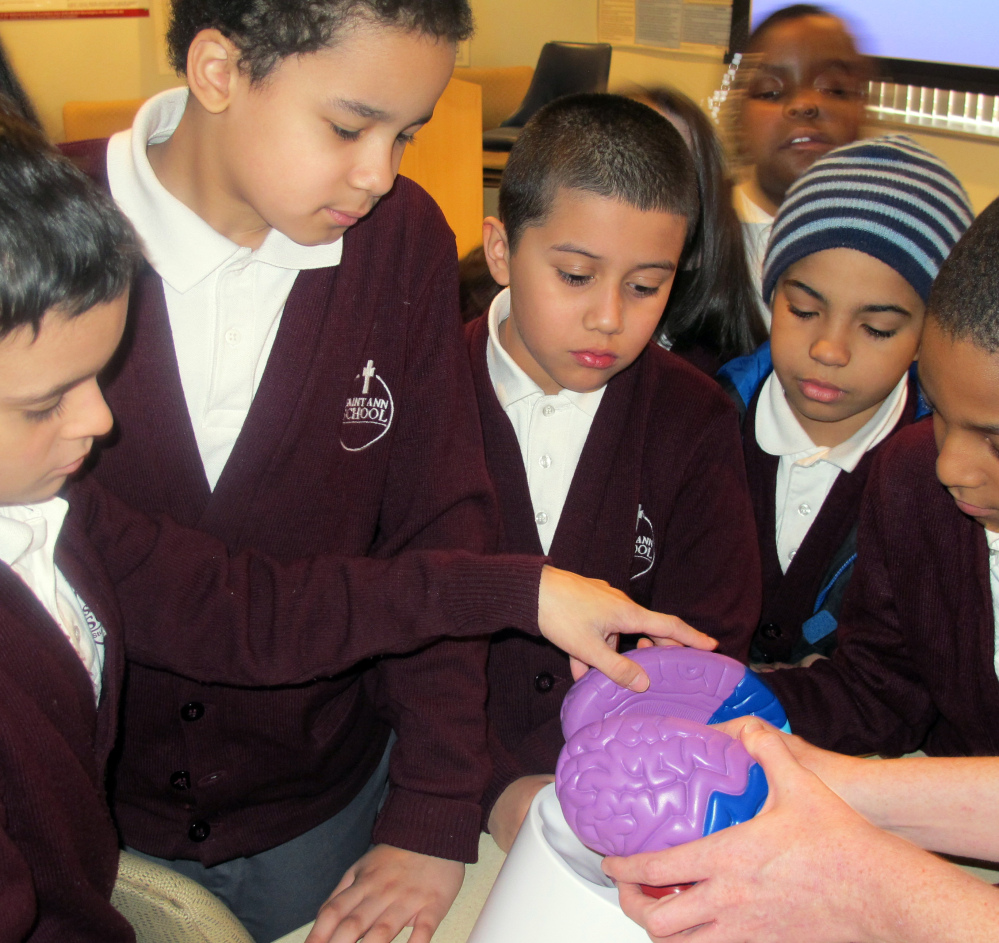NEW YORK — Andrea Esteban tried to smile with half her face, crossing her eyes in the process, and her third-grade classmates giggled. Matthew Velez struggled to speak, “Luh, luh, uh, gronk,” and the kids erupted in laughter.
But the funny faces, the gibberish and some arm flapping were all part of a serious lesson to help kids learn the telltale signs of a stroke by imitating them. The idea is to enlist children, particularly those who may live with older relatives, as an army of eyes to help recognize the warning signs, get help for victims more quickly and hopefully save lives.
“If my mom has a stroke, I’ll know what to do,” said 10-year-old Madison Montes. “Run to the phone and call 911.”
The experimental health education program at Montefiore Medical Center in the Bronx is aimed at the most crucial factor when it comes to a stroke: time.
Each year, about 795,000 Americans have a stroke and about 130,000 die. Some are caused by bleeding in the brain, but the vast majority is caused by a clot that blocks blood flow, starving brain cells. The drug TPA can dissolve those clots and reduce disability but only if it’s given within three to four hours of the first symptoms, and the sooner the better. Yet only about 5 percent of patients receive it, in part because many stroke sufferers don’t get to the hospital in time for testing to tell if they’re a candidate.
The early warning signs include a droopy side of the face, slurred or strange speech, and the inability to keep arms raised.
“There’s a pretty good chance some children might witness a parent or a grandparent having a stroke,” said Jim Baranski, CEO of the National Stroke Association. “So if they’re armed with the signs and symptoms, they could likely save a life.”
Montefiore’s program, one of a handful tried across the country, has been used since 2012 with private schools in its neighborhood, where children are often in a grandparent’s care because parents are absent or both working. The goal is to study the results and, if successful, replicate the program across the country.
“The kids get a kick out of it because they get to do a little acting,” said Dr. Robert Glover, a neurologist who helped develop the program. “But when they’re done, they know about stroke and they can teach their families.”
Dr. Kathryn Kirchoff-Torres, who led the class from St. Ann’s School in the Bronx, said the kids are already “little message machines” bringing home from school what they learn about the benefits of exercise, not smoking and eating well.
At the start of the stroke class last month, in a first-floor room at the hospital, the doctor asked, “Who knows what a stroke is?”
“A heart attack?” one child offered.
“Well, we like to call it a brain attack,” Kirchoff-Torres said. “It’s a problem with the brain.” She then taught the children to use the word “FAST” as a memory device. With cartoons and music bringing the point home, they learned “F’’ is for face, “A’’ is for arms, “S’’ is for speech and “T’’ is for time.
After the play-acting and the multimedia show, the doctor invited questions from the children.
“How do you catch a stroke?” one boy asked. The doctor assured him that strokes are not contagious but can be caused by “high blood pressure, smoking cigarettes, junk food.”
One parent in attendance, Jason Sawtelle, said he felt the lesson “plants the seed”
“Maybe not every 8-year-old is capable of this,” he said, “but some certainly are.”
Copy the Story LinkSend questions/comments to the editors.



Success. Please wait for the page to reload. If the page does not reload within 5 seconds, please refresh the page.
Enter your email and password to access comments.
Hi, to comment on stories you must . This profile is in addition to your subscription and website login.
Already have a commenting profile? .
Invalid username/password.
Please check your email to confirm and complete your registration.
Only subscribers are eligible to post comments. Please subscribe or login first for digital access. Here’s why.
Use the form below to reset your password. When you've submitted your account email, we will send an email with a reset code.